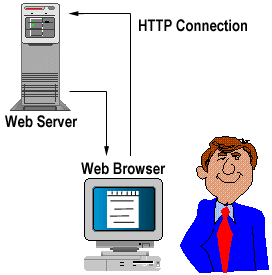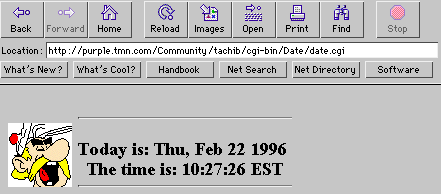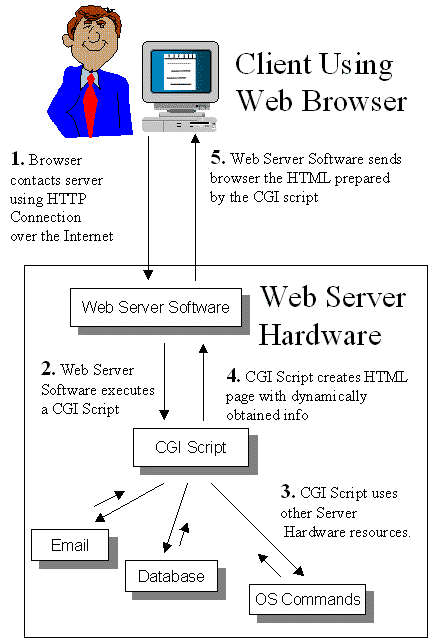Server-side Scripting
What the heck is Web Programming anyway?
At some point along the way webmasters around the net realized that HTML (1) was too limited to do many of the things that they wanted to accomplish.How could a webmaster display the current time and date on every page accessed by a client? How could she collect information about clients who were accessing her web site? How could she create a web site that was more than just an information warehouse, but a meaningful and dynamic conversation?
Certainly, HTML was great for distributing "pre-prepared" web pages on request. A client would use a web browser to contact a web server and use HTTP to ask the web server for a specific HTML document. (2) The web server would then send the requested document back to the web browser which in turn, would display the document as defined by the HTML to the client.

Pretty nifty really, and far superior to older technologies like gopher and ftp. However, the interaction between the client and the server was still extremely trivial. The server could only provide HTML documents which had been specially encoded by a webmaster, and which had been placed in certain publicly-accessible directories. The interaction between web browser and web server was pretty mind numbingly simplistic and the coolness of surfing through hyperlinks quickly became droll.
HTML fell short of anything truly "dynamic".
For example, to put the current date on every page using only HTML would require a webmaster to manually edit every file, every day. As you can imagine, this got tiring very quickly for sites with more than 5 pages. Webmasters needed a way to have HTML pages created and modified "on-the-fly," with information which could change weekly, daily, by the second, or for each and every request. And they needed those pages to be modified automatically, without their constant oversight.

As it so happens, the hardware which web server software runs on typically has quite a few resources which can be utilized to help solve these problems. Not only do servers have processing power to spare, they also have a battery of applications (such as e-mail, database manipulation, or calendaring) already installed and ripe for utilization.
And thus was born CGI (Common Gateway Interface). (3)
CGI: The Birth of Server Side Web Programming.
As with most computer jargon, the term Common Gateway Interface can be fairly meaningless at first glance. So, before getting into what CGI can do, let's take a moment to define what CGI actually is.- Common - CGI programs can be written with many languages. CGI can be programmed in C, C++, Java, Perl, Visual Basic, or any other language which can accept user input, process that input, and respond with output.
- Gateway - CGI's usefulness does not stem from what it can accomplish by itself, but what it can accomplish by making partnerships with other resources.
- Interface - CGI is not a language. Neither is it a program. CGI is a standard of communication, a process, an interface which provides well-defined rules for creating partnerships. The benefit is that if everyone follows the rules of the interface, then everyone can talk to each other. Thus, typically we say that we write "CGI programs" or "CGI scripts" which perform the functions of the common gateway interface.
Further, CGI works with many different types of systems. CGI works on Mac, NT, Windows, OS2, Amiga, UNIX, and pretty much every operating system which runs web server software.
By the way, if you use a "platform independent" language like Perl or Java to write your CGI script, the exact same CGI script can be moved directly from one platform to another without it breaking! (4)
I often see CGI as a middleman or a translator whose job it is to help more powerful resources like databases, graphics generation programs, or network applications talk to each other and work towards a common solution.
CGI is the gateway between the lone web surfer with her trusty web browser and the vast web of computers (each with their own specific language and protocols) and computer programs (each with their own interfaces and methods of output).
CGI translates between the language the client speaks (perhaps HTMLized English) and the multitude of languages spoken by the resources the client wants to utilize (such as SQL for relational databases). This is a crucial job, cause let me tell ya, my grandmother does not want to know how to speak SQL when she is browsing the web!

Okay, so that is probably a lot of abstract stuff to take in all at once, especially if you have not worked with CGI already. So let's back up a minute and go over what CGI is by looking at it in the wild. Let's look at some examples of CGI in action. You can easily see that CGI makes for a much more profound surfing experience allowing web sites to offer useful and compelling services to surfers who may be interested in information or products offered. (5) However, there is a dark side!
Client-side scripting (Part two)
Footnotes
- The Web Developer's Virtual Library has an excellent HTML Primer if you need a refresher on what HTML is! But basically, HTML (Hyper Text Markup Language) is a way of describing how a web browser should display text and images. HTML codifies page layout into a series of instructions called "HTML tags". The job of Web Browser programs is to translate ugly HTML instructions into the beautiful web pages we see while surfing.
- Okay so there are quite a few jargon words in that sentence which might need quick explanations.
- Truthfully much of what is done by CGI can also be done using SSI (Server Side Includes) which is a service provided by web server software in which certain HTML comment tags can be used to execute commands. SSI will not be covered this month since it demands its own article, however, for the purposes of this introduction, SSI programs are similar enough in theory to CGI programs that they can be thought of as the same thing.
- When you get some software for your computer and you have to get the special "Mac Version" or "Windows Version", you are getting a "platform dependent" program. Unfortunately, when you move from being a PC user to being a Mac user, you have to buy all new programs because the programs you bought for Windows will not work on Mac. The beauty of web programs is that they are typically "platform independent" which means that you can run them anywhere. Whether you use a PC, Mac or Unix box, the programs will work just fine.
- CGI is not the only form of server-side scripting available, of course. For example, Netscape's Live Wire is an online development environment for Web site management and client-server application development. It uses JavaScript, Netscape's scripting language, to create server-based applications similar to CGI programs. Unlike CGI programs, however, LiveWire applications are closely integrated with the HTML pages that control them. However, non-CGI server side strategies are best covered in their own article.
In this column we will use the word "client" to refer to a person who is using a "web browser" program like Netscape Navigator or Internet Explorer to display HTML documents received from a "web server".
A web server is a combination of hardware (an actual computer which stores all of the HTML files) and software (the program which listens for web browser requests and utilizes the hardware resources to fulfill those requests).
Web browsers and web servers communicate using HTTP (Hyper Text Transfer Protocol) which provides a communication standard for efficient and intelligible dialog. Essentially HTTP allows a web browser to contact a web server somewhere on the web and ask for a specific document (or resource). It also allows the server to send the requested document (or execute the resource) back to the web browser.